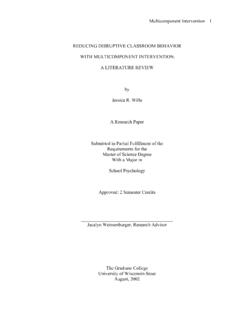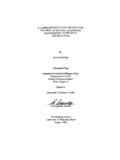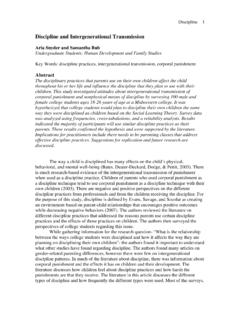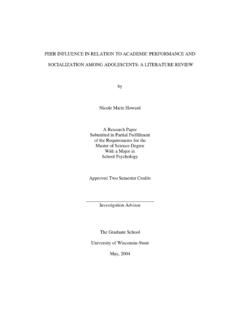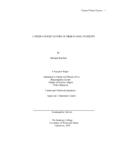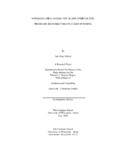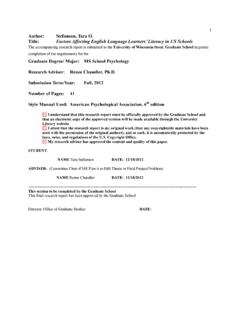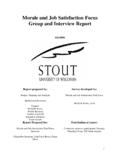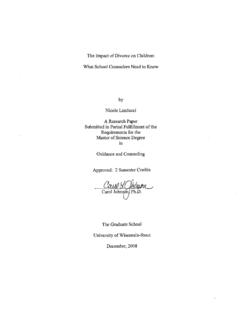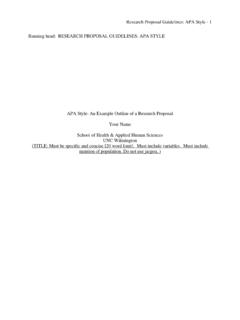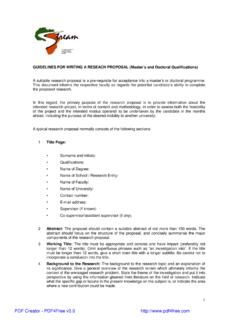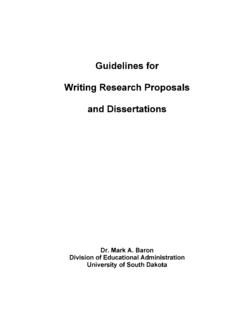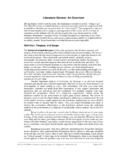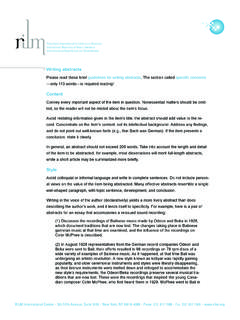Transcription of A LITERATURE REVIEW AND CRITICAL ANALYSIS …
1 A LITERATURE REVIEW AND CRITICAL ANALYSIS OF SCHOOLVIOLENCE AND TEACHERS PERCEPTION OFTHE ZERO TOLERANCE POLICYbyDana R. KonterA Research PaperSubmitted in Partial Fulfillment of theRequirements for theMaster of Education Degree With a Major inSchool PsychologyApproved: 2 Semester Credits_____Investigation AdvisorThe Graduate CollegeUniversity of Wisconsin-StoutAugust, 2000 Zero Tolerance 2 The Graduate CollegeUniversity of Wisconsin-StoutMenomonie, WI (Writer) (Last Name) (First) (Initial)A LITERATURE REVIEW and CRITICAL ANALYSIS of School Violence andTeachers Perception of the Zero Tolerance Policy_(Title)School Psychology____Denise Maricle____August, 2000_____38____(Graduate Major) (Research Advisor) (Month/Year)(No. of Pages)Publication Manual of the American Psychological Association,Fourth Edition(Name of Style Manual Used in this Study)As a precursor to a proposed study examining teacherperceptions of the zero tolerance policy, this paper will reviewand critically analyze research and LITERATURE pertaining toschool violence and zero tolerance policies.
2 The goal of theproposed research is to identify the benefits, drawbacks, andperceived effectiveness of the zero tolerance policy as apreventative tool against school violence. The researchhypothesis for the proposed study is that the majority of publicschool teachers will believe the zero tolerance policy isineffective, has a negative impact on students, and does notprevent school violence; that is it does not fulfill its Tolerance 3 AcknowledgmentsI would like to offer my most sincere thanks and appreciationto the following individuals for making the completion of thisproject possible:Dr. Denise Maricle, UW-Stout School Psychology faculty member and my research advisor. Thank you for your time, cooperation, and encouragement. Also, thank you for your many ideas and strategies along the Nelson.
3 Thank you for volunteering your encouragement and endless hours of Tolerance 4 Table of , Purpose, and Significance of Proposed StudyResearch QuestionsReview of Level of ViolencePerception of ViolenceEffects on EducationActions Taken by SchoolsSchool Based Prevention PlansZero ToleranceConclusionResearch , Significance, and Rationale of the Proposed StudySubjectsInstrumentationResearch QuestionsProposed Data ANALYSIS MethodsCritical of Current Research Cover LetterB. Consent Form and SurveyZero Tolerance 5A LITERATURE REVIEW and CRITICAL ANALYSIS of School Violence andTeachers Perceptions of the Zero Tolerance PolicyIntroductionSchool violence has caught the attention of nearly everyonein the United States. With the recent shootings at schools acrossthe country, people have become increasingly concerned about thesafety and well-being of their school-age children while theyattend school.
4 In the eyes of society, school is supposed to be asafe place for children to learn and grow (Furlong & Morrison,1994), not a place of violence and the regularity with which violent incidents arereported in schools across the United States, there appears to bean obvious increase in the number of violent acts in , the statistics available through recent researchindicate that the number of violent acts is not increasing(Rubel, 1978; Scherer & Stimson, 1984; Wayson, 1985), but, is infact declining (Grier & Chaddock, 1999).Despite the statistical decline of violent acts in schools,the perception of school violence has increased significantly(Furlong & Chung, 1995). Furlong and Chung (1995) reports thatthe media contributes to the perception that school violence isrampant through its extensive coverage of recent tragicincidents.
5 Fostered by the media, violence is perceived to be anincreasing and serious problem in schools across the have reported increased fears about dropping theirZero Tolerance 6children off at school and some parents are reluctant to sendtheir children to school altogether (Weaver, 1993). Not only arestudents affected, but teachers have also reported fears. Reportsof such violent incidents have a devastating impact on students,school personnel, and the community (Chandras, 1999).As the fears of school violence increase, a child seducation can be significantly affected. The opportunity for asuccessful education is seriously jeopardized when students,staff members, and the community fear both going to school andremaining after (Mulhern, Dibble, & Berkan, 1994). The perceptionof school violence, in itself, has the ability to physically andpsychologically harm individuals; preventing them from achievingtheir maximum physical, social, or academic potential (Furlong,Morrison, & Clontz, 1993).
6 School districts have attempted to address the problem ofschool violence in various ways. In many schools, crisisintervention approaches have become the treatment of choice(Wolfe, 1995; Chandras, 1999) while other school districts havefound that preventative actions and plans are the key ( of Education, 1999). Despite the method of preventionor intervention a district chooses, the type of plan and theinformation included within it varies significantly from districtto district. Some believe crisis plans should include a code ofconduct: specific rules and consequences that can accommodatestudent differences on a case-by-case basis ( Department ofZero Tolerance 7 Education, 1999), while others believe there should not be anyaccommodations or altering of disciplinary actions.
7 Rather, thereshould be a collaboration between schools, law enforcement, thecourts, community agencies, parents, and the public (Mulhern,Dibble, & Berkan, 1994) that have rigid guidelines for particular prevention strategy of interest is the zerotolerance policy. Since the introduction of zero tolerancepolicies to the schools in the 1990 s (Western Governors Association, 1999), significant controversy regarding theirefficacy has been generated. A zero tolerance policy is definedas a school or district policy that mandates predeterminedconsequences or punishments for specific offenses ( of Education, 1998). The purpose of a zero tolerancepolicy is to create a safe and secure environment for tolerance policies have generated significantcontroversy regarding their appropriateness and believe the policy is too strict (Baldauf, 1999; Heaney &Michela, 1999), that there should be leniency for actions thatmay appear to be something they are not.
8 Additionally, the policydoes not accommodate less threatening situations. Others see zerotolerance as being too broad based (Chaddock, 1999). They feelthere are not enough guidelines for disciplining violent acts andfor determining which actions receive which disciplinaryresponses. As a result of these concerns, the zero toleranceZero Tolerance 8policy is considered inappropriate or ineffective in preventingschool the many concerns associated with zero tolerancepolicies in the schools, there are some educators who believethis is a much-needed policy (Skiba & Peterson, 1999). Theyrecognize that there could be some flaws; they argue, however,most policies have room for improvement. Supporters of zerotolerance believe it is appropriate if it is imposed with commonsense.
9 They also contend that it is not intended to be a solutionin itself (Grier & Chaddock, 1999). At the same time, supportersof the zero tolerance policy acknowledge that its effectivenessis yet to be determined. Due to a lack of much needed research,there is no evidence supporting the efficacy of the zerotolerance policy (Skiba & Peterson, 1999). The research proposedin this paper will attempt to fill that are currently a variety of opinions about which typesof preventative measures are effective and which ones are (Skiba & Peterson, 1999; Grier & Chaddock, 1999) revealconflicting opinions about the zero tolerance policy. Zerotolerance policies in the schools have not been around longenough to be extensively researched. However, with the recentperception of increased violence in the schools, research needsto be done to determine its effectiveness and that is determined, preventative methods towards schoolZero Tolerance 9violence can be readily , Purpose, and Significance of the Proposed StudyThe purpose of this paper is to REVIEW and criticallyanalyze the research and LITERATURE pertaining to school violenceand zero tolerance policies as a precursor to a proposed studyexamining teacher perceptions of the zero tolerance policy.
10 Theproposed study is important because of the potential impact itcould have on children, teachers, administrators, and society. Itwill provide beneficial information towards directing schools inthe right direction when it comes to the prevention of schoolviolence. With the perception that violence is increasing in theschools, the concern about the safety and well being of facultyand students is also increasing. So, it is necessary to determinewhether or not the zero tolerance policies in the schools are aseffective and appropriate as they were intended to be. Theresearch hypothesis for this study is that the majority ofteachers in the public school system see the zero tolerancepolicy as having a negative impact on students and the preventionof school Tolerance 10 Research QuestionsBased upon the preceding discussion, the following researchquestions would be proposed:1.
